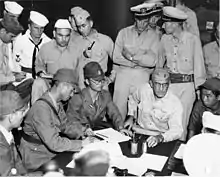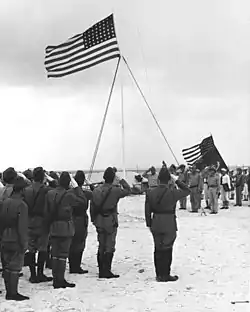Shigematsu Sakaibara
Shigematsu Sakaibara (酒井原 繁松, Sakaibara Shigematsu, December 28, 1898 – June 19, 1947) was an admiral in the Imperial Japanese Navy, the Japanese garrison commander on Wake Island during World War II, and a convicted war criminal.
Shigematsu Sakaibara | |
|---|---|
 Admiral Shigematsu Sakaibara (seated second from left) signing the surrender of Wake Island aboard USS Levy on September 4, 1945 | |
| Born | December 28, 1898 Yamagata Prefecture, Japan |
| Died | June 19, 1947 (aged 48)[1] Guam, United States |
| Allegiance | |
| Service/ | |
| Years of service | 1918-1945 |
| Rank | |
| Commands held | 65th Base Garrison (Wake Island) |
| Battles/wars | World War II Battle of Wake Island |

Biography
A native of Yamagata prefecture in northern Japan, Sakaibara was a graduate of the 46th class of the Imperial Japanese Navy Academy in 1918, placing 36th in a class of 124. He served his midshipman tour on the cruiser Tokiwa, and after his commission as an ensign, was assigned to Hirado. He later served on the destroyer Kaba and battleship Mutsu.
As a sub-lieutenant, he served on the Iwate and after his promotion to lieutenant on December 1, 1924, he was assigned to the Hiei, Yura, and Sendai. He was chief gunnery officer on the Tatsuta. Promoted to lieutenant commander in 1930, he served as chief gunnery officer on Takao in 1934, followed by Mutsu in 1935. He was executive officer on Chikuma in 1939. After his promotion to captain in 1940, he served in a number of staff positions.
After the Battle of Wake Island on December 23, 1941, Sakaibara was appointed the garrison commander of the Japanese occupation force. Fearing an imminent attempt by American forces to retake the island, Sakaibara put the captured American prisoners of war to work building a series of bunkers and fortifications in preparation for a suspected amphibious invasion.
On October 5, 1943, aircraft from USS Yorktown bombed Wake Island. Two days later, fearing an imminent invasion, Sakaibara ordered the execution of the 98 civilian prisoners remaining on Wake Island. They were taken to the northern end of the island, blindfolded and machine-gunned. One prisoner (whose name has never been discovered) escaped, carved a message into a rock about the incident but was then recaptured and personally beheaded by Sakaibara.
However, despite the massive assembly, the attack never came. Instead the United States Navy established a submarine blockade, causing the Japanese garrison to starve. United States forces bombed the island periodically from 1942 until Japan's surrender in 1945.
Sakaibara was promoted to rear admiral a year later, on October 15, 1944. The Japanese garrison on Wake Island formally surrendered to the United States on September 4, 1945.
After the war, Sakaibara was taken into custody by the American occupation authorities, extradited to Guam, and sentenced to death by a military tribunal for war crimes in connection with his actions on Wake Island. He was hanged on June 18, 1947. Until the end, he maintained, "I think my trial was entirely unfair and the proceeding unfair, and the sentence too harsh, but I obey with pleasure."[2]
References
Notes
- Nishida, Imperial Japanese Navy.
- Hubbs, Mark E. "Massacre on Wake Island". Archived from the original on 2006-05-22. Retrieved 2006-06-03.
Books
- Devereaux, Colonel James P.S., USMC (1947). The Story of Wake Island. The Battery Press. ISBN 0-89839-264-0.CS1 maint: multiple names: authors list (link)
- Fuller, Richard (1992). Shokan: Hirohito's Samurai. London: Arms and Armour Press. ISBN 1-85409-151-4.
- Sloan, Bill (2003). Given up for Dead: America's Heroic Stand at Wake Island. Bantam Books. ISBN 0-553-80302-6.
- Uwrin, Gregory J.W. (1997). Facing Fearful Odds: The Siege of Wake Island. University of Nebraska Press. ISBN 0-8032-9562-6.
External links
- Nishida, Hiroshi. "Imperial Japanese Navy". Archived from the original on 2013-01-30. Retrieved 2007-08-25.
- The Defense of Wake
- A Magnificent Fight: Marines in the Battle for Wake Island
- Part Three: The Defense of Wake
- Spennemann, Dirk H.R. (2000–2005). "To Hell and Back: Wake During and After World War II". Digital Micronesia. Charles Sturt University. Retrieved January 23, 2007.